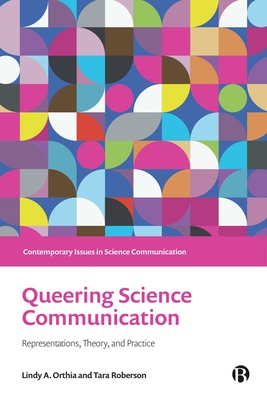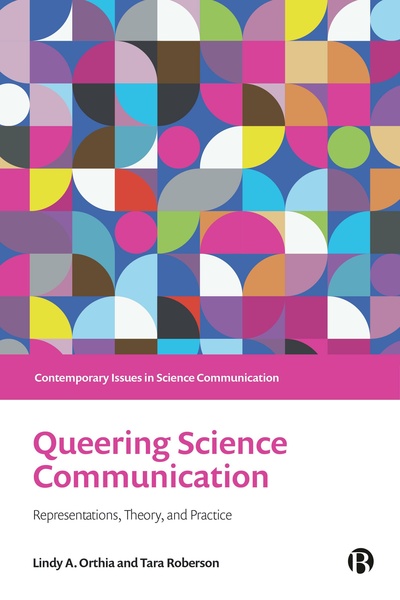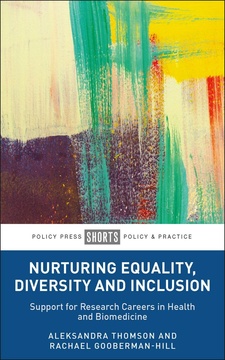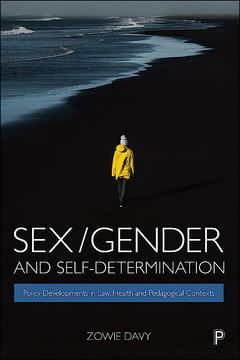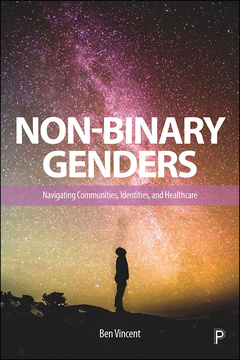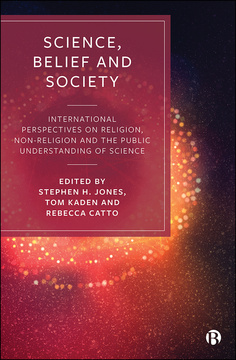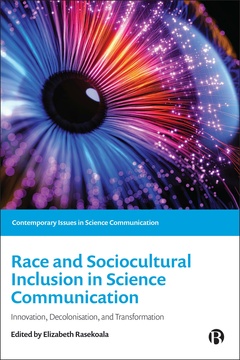Queering Science Communication
Representations, Theory, and Practice
Edited by Lindy A. Orthia and Tara Roberson
Published
Nov 12, 2024Page count
238 pagesBrowse the series
Contemporary Issues in Science CommunicationISBN
978-1529224412Dimensions
234 x 156 mmImprint
Bristol University PressPublished
Apr 28, 2023Page count
238 pagesBrowse the series
Contemporary Issues in Science CommunicationISBN
978-1529224405Dimensions
234 x 156 mmImprint
Bristol University PressPublished
Apr 28, 2023Page count
238 pagesBrowse the series
Contemporary Issues in Science CommunicationISBN
978-1529224429Dimensions
234 x 156 mmImprint
Bristol University PressPublished
Apr 28, 2023Page count
238 pagesBrowse the series
Contemporary Issues in Science CommunicationISBN
978-1529224429Dimensions
234 x 156 mmImprint
Bristol University PressWatch the series launch with Tara Roberson.
In the media:
Through the `queering' glass: looking at science communication from a queer lens in the Journal of Science Communication
On the blog:
Science communication should give LGBTIQA+ people power
A book on queer themes and science communication is timely, if not well overdue.
LGBTIQA+ people have unique contributions to make and issues to meet through science communication. So, bringing ‘queer’ and ‘science communication’ together is an important step for queer protest, liberation, and visibility.
This collection examines the place of queer people within science communication and asks what it means for the field to ‘queer’ science communication practice, theory and research agendas.
Written by leading names in the field, it offers concrete examples for academics, students and practitioners who strive to foster radical inclusivity and equity in science communication.
"The book serves as a great example for not only integrating insights across the continuum of research, practice and teaching in science communication, but also for employing a critical Science and Technology Studies (STS) lens for reflecting on our field’s assumptions, practices and historical frameworks." Journal of Science Communication
"Queering Science Communication is a long overdue critical intervention, bringing queer perspectives, insights, and theories to bear on science communication. It is a fascinating read, elegantly written, and will inevitably become essential reading for anyone interested in science communication. The authors make a significant and novel contribution to science communication theory, practice, teaching, and research." Emily Dawson, University College London
Tara Roberson is Postdoctoral Researcher in the Australian Research Council Centre for Excellence for Engineered Quantum Systems at The University of Queensland.
Lindy A. Orthia is Honorary Senior Lecturer of Sociology at The Australian National University.
Introduction - Tara Roberson and Lindy A. Orthia
Part 1: Negotiating Queer Identities with Science, Technology, and Medicine
1. Where to ‘Keep’ the Queer: Contestations and Anxieties in Clinical Communications - Aritra Chatterjee
Practice Spotlight: Gender and Sex in Research Communications - Sophia Frentz
2. The Question of Queer Complexity: Science Communication and Queer Activism - V de Kauwe and Emily Standen
3. Queer Interests in Technology and Innovation Discourse - Tara Roberson
Practice Spotlight: All We Need Is … The Endosymbiotic Love Calendar - Annalaura Alifuoco, Natalie E.R. Beveridge, Yasmine Kumordzi, and Hwa Young Jung
Practice Spotlight: GENDERS: Shaping and Breaking the Binary, an Exhibition at Science Gallery London - Helen Kaplinsky and Jessie Krish
Teaching Notes for Part 1
Part 2: Representations of Queerness in Public Science Communication
4. Queering Science Museums, Science Centres, and Other Public Science Institutions - Eleanor S. Armstrong and Simon J. Lock
Practice Spotlight: Queer by Nature: The LGBTQ+ Natural History Tour - Josh Davis
Practice Spotlight: Science Queers: Overacted Representation in Science Communication - Òscar Aznar-Alemany
Practice Spotlight: Science is a Drag! Online Events - Carla Suciu, Brynley Pearlstone, and Sam Langford
5. Queer Characters in Science-themed Fiction - Lindy A. Orthia and Leo P. Visser
Practice Spotlight: Using #QueerInSTEM and Related Hashtags to Promote Your Science Communication - Luis Lopez and Alberto I. Roca
Practice Spotlight: Queer Science Blogs: Public Communication Before the Age of Social Media - Ron Buckmire and Alberto I. Roca
Teaching Notes for Part 2
Part 3: Queer People in Science Communication Communities
6. Malayang Paglaladlad para sa Mapagpalayang Paglalahad: Coming Out and Queering Science Communication in Contested Spaces - John Noel Viaña, Mario Carlo Severo, Miguel Barretto-Garcia, Paul James Magtaan, Jason Tan Liwag, Roemel Jeusep Bueno, Christer de Silva, and Shaira Panela
Practice Spotlight: Queer Scientists PH: Visibility Towards Community Building and Empowerment - Jason Tan Liwag, Jay S. Fidelino, Rey Audie S. Escosio, Almira B. Ocampo, and Nikki Santos-Ocampo
Practice Spotlight: 500 Queer Scientists at the Sydney Gay and Lesbian Mardi Gras - Alice Motion and Hervé Sauquet
7. Including Queerness and Improving Belonging of Intersectional Queer Identities in Science Communication Communities - Katherine Canfield
Practice Spotlight: Rainbow Spectrums: Embracing Our Queer Disabled Family in Science Communication - V de Kauwe and Kai Fisher
8. Have Rainbow, Will Collect Data: How Citizen and Community Science Engages Queer Volunteers - Todd A. Harwell
Teaching Notes for Part 3
Part 4: Queering Institutional Science Communication Agendas
9. Science OUTreach: A Queer Approach to Science Communication Practice - Alice Motion and Lee Wallace
Practice Spotlight: Queer Communicators in Environmental, Climate Change, and Sustainability Conversations - Franzisca Weder
Practice Spotlight: How LGBTIQA+ Representation in Organization Leadership Impacts Inclusivity and Visibility - Sarah Durcan and Andrea Bandelli
Practice Spotlight: Outer Edge: Queer(y)ing STEM Collections – A Community Workshop - Eleanor S. Armstrong and Sophie Gerber
10. The Possibilities of Queer in Science Communication Teaching and Pedagogies - Simon J. Lock and Eleanor S. Armstrong
11. Queering Science Communication Theory Beyond Deficit and Dialogue Binaries - Lindy A. Orthia and V de Kauwe
Teaching Notes for Part 4
Conclusions - Tara Roberson and Lindy A. Orthia







